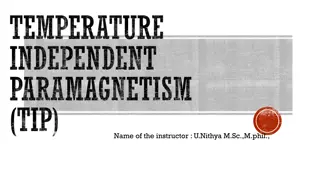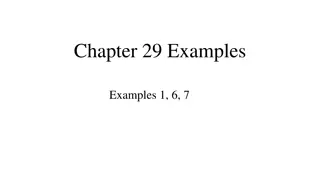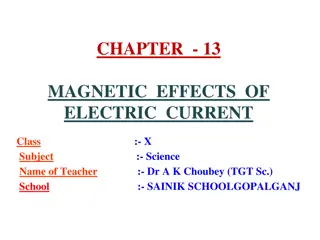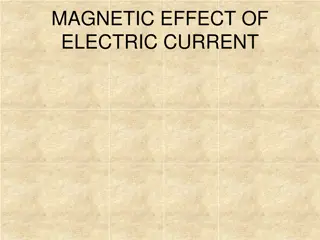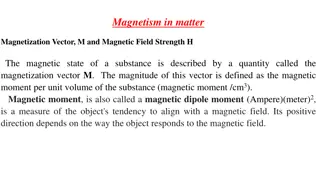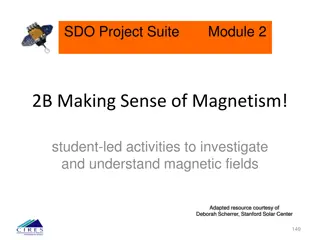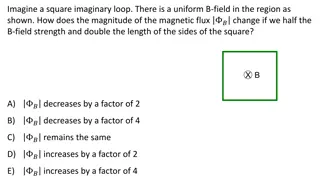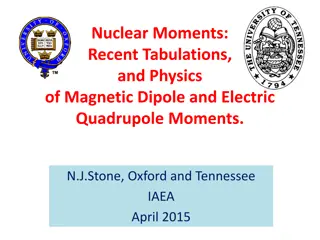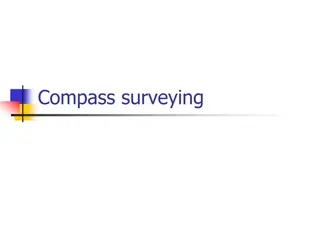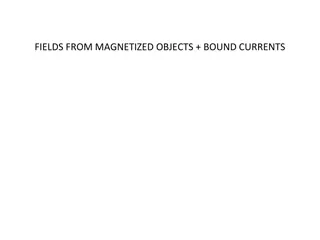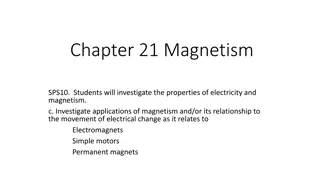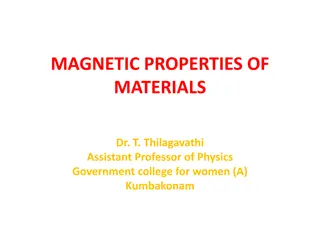Understanding Magnetic Moments and Susceptibilities in Materials
Determination of magnetic moment and susceptibility plays a crucial role in studying the magnetic properties of materials. This involves methods like Guoy balance for paramagnetic substances and observing weight changes for diamagnetic substances. The Faraday method, employing a quartz container in a strong magnetic field, is also utilized. The calculations involve the use of known parameters and standards to determine magnetic characteristics accurately.
Download Presentation

Please find below an Image/Link to download the presentation.
The content on the website is provided AS IS for your information and personal use only. It may not be sold, licensed, or shared on other websites without obtaining consent from the author. Download presentation by click this link. If you encounter any issues during the download, it is possible that the publisher has removed the file from their server.
E N D
Presentation Transcript
Determination of magnetic moment Name of the instructor:U.Nithya M.Sc.,M.Phil.,
Determination of magnetic susceptibility using Guoy balance method: Paramagnetic substance when a substance is suspended between the two poles of an electromagnet The current is switched on,it experiences a force acting along its length. The substance will be drawn downward by the electromagnetic field if it is paramagnetic. The weight of the substance will increase in weight the magnetic susceptibility is calculated.
Calculation: Increase in weight m = m2-m1 The paramagnetic susceptibility is calculated from the equation mg = ( x axa) AH2 g= Accelaration due to gravity = Density of the substance x= Mass susceptibility of the substance a= density of air Xa= mass suscetibility of air A= Area of cross section of the cylinder H= strength of the magnetic field in gauze axais known to be 0.036x10-6
If a standard substance is taken for which the specific magnetic susceptibility x and are known then. m/ mW= x- axa/ wxw- axa where m = weight change for the substance mW = Weight change for water . = Density of the substance a = Density of air Xa = mass susceptibility of air X = mass susceptibility of the substance w= density of water xw= mass susceptibility of water
Diamagnetic substance. In the case of diamagnetic substances the cylinder will be pushed upwards by the electromagnetic field because diamagnetic substances are repelled by the magnetic field. The weight of the substance will decrease apparently. weight change of the substance and X can be calculated. weight change and X will be negative
FARADAY METHOD: A very small volume of the magnetic sample is packed in a container made of quatrz. It is suspended from a balance in the region of strong magnetic field. The product H(dH/dx) should be constant over the volume of the sample. H is the field strength and dH/dx is the gradient of the field. The whole set-up is placed in nitrogen or helium atmosphere. The region of uniform H(dH/dx) is determined by placing a small quantity of a substance of mass m and the magnetic susceptibility. H (dH/dx) =(dF/m ) Where dF is the force. It measured by using catheometer. The magnetic susceptibility is first measured for the standard substance and then for the sample. s= 0(ds/d0)(m0/ms) where sand 0 are the magnetic susceptibilities of the sample and the standard, ds and d0are the feflections,msandm0are the respective mass.
Calculation of molar magnetic Susceptibility: molar magnetic susceptibility is obtained by multiplying x of the substance with molecular weight. XM= XM
Magnetic properties of lanthanides and actinides: Lanthanides: The inner transition series lanthanides are trivalent and have eletronic vonfiguration [xe]4fn (n=0 to 14. from La to Lu). The magnetism arises due to the electrons of 4f level. It is incomletely filled and is effectively shielded by 5s and 5p orbitals. They are not influced by the surrounding ligands. The crystal field effect is very small and there is strong spin-orbit coupling. The spin orbit coupling is of the order of 1000 cm-1 J is a good quantum number Therefore the magnetic moments is given by J= g [J(J+1)]1/2
Where g magnetogyric ratio. Bohr magnetron J= L+S to L-S This equation is applied to all the lanthanides except for those having f0,f7and f14 configurations. The external fields do not either split the free ion term or quench the orbital angular momentum. For them L=S and therefore J= S For such systems s = [4s (s+1)] or S =n(n+2)]1/2 Gd 3+ has seven unpaired electrons (f7) and S. = 7.9 B.M The only two lanthanides which do not obey the Jequation are samarium (III) and europium (III).
From the graph it is seen that for most of the elements there is excellent agreement between the calculated values using the spin orbit coupling formula and experimental values measured at 300k.
a- J=|L-S| for less than half filled configuration J = | L+S| for more than half filled configuration L and S values for electrons when the configuration less than half filled; L and S values for holes when the configuration is more than half filled. b. g= 1+ J(J+1) + S(S+1)- L(L+1)/ 2J(J+1) c. = g[J(J+1)]1/2 Actinides: similar to lanthanides actinides also have incompletely filled 5f orbitals. The 5f orbitals are poorly shielded and the shielding depends upon the oxidation state.
Since there is poor shielded the actinides have very high crystal field effects than the 4f orbitals of lanthanides. It is one tenth of the first transition series elements and ten times that of lanthanides. The actinide complexes have the magnetic exchange phenomenon. j-j coupling plays major rule in actinide elements. For the same fnconfiguration the magnetic moment of actinide is lower than that of a lanthanide. The 5fnelecteons have considerable quenching of orbital magnetic moment. pu (III) 5f5and Am(III) 5f6have magnetic moments similar to their lanthanide counterparts sm (III) 4f5 and Eu (III) 4f6. The spin poulation in the ground state is thermally controlled.





